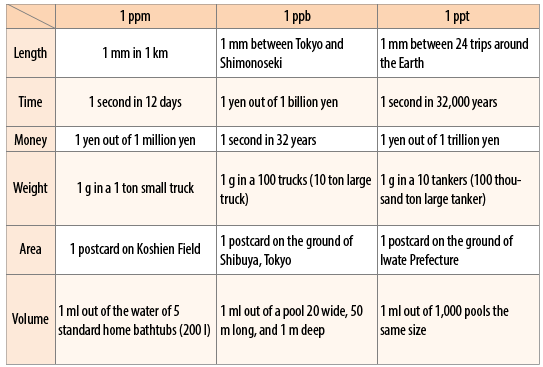Tokyo Food Safety Information Center » Tokyo Metropolitan Government food safety FAQ »I’ve heard that standards for pesticide residues are measured in “ppm,” but how much is this?
I’ve heard that standards for pesticide residues are measured in “ppm,” but how much is this?

I’ve heard that standards for pesticide residues are measured in “ppm,” but how much is this?
- This isn’t a measurement I’m familiar with and I don’t really understand how much it means.

“ppm,” meaning “parts per million,” is a unit expressing concentration and proportion. “1 ppm” means 1 part of something in 1 million parts of something else.
Detecting 1 ppm of a pesticide would mean, for example, that 1 kilogram of an agricultural product contained 1 milligram of pesticide.


“ppm” is an abbreviation of “parts per million.” This means that “1 ppm” represents 1 part of something in 1 million parts of something else. In terms of a percentage, 1 ppm is equal to 0.0001%.
ppm is used to express extremely small concentrations and proportions, like air pollutants such as nitrogen dioxide; concentrations of pesticide residue; and the composition of trace elements in rocks.
In recent years, in line with advances in analysis technologies, we have become able to verify the presence of even smaller, incredibly miniscule amounts of substances, like ppb (parts per billion) and ppt (parts per trillion).
The table below represents these three units with a few, more familiar things.

Source: Yutakana shokuseikatsu, Foundation for Education of Science and Technology
ppm is used to express extremely small concentrations and proportions, like air pollutants such as nitrogen dioxide; concentrations of pesticide residue; and the composition of trace elements in rocks.
In recent years, in line with advances in analysis technologies, we have become able to verify the presence of even smaller, incredibly miniscule amounts of substances, like ppb (parts per billion) and ppt (parts per trillion).
The table below represents these three units with a few, more familiar things.

Source: Yutakana shokuseikatsu, Foundation for Education of Science and Technology